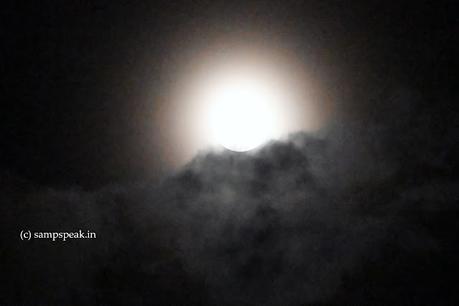It is the brightest and most attractive object on night sky ! – the moon – taken on a cloudy day !

The heart of summer is hitting still, one does not feel it was July and the astrology of August is heating up fast, as this year’s fiery new moon in Leo is rising on the morning of Aug. 4. The sassy and star-powered energy of Leo season is firing up everyone’s confidence, so this lunation is a great time for all zodiac signs to gas themselves up with some extra self-love and pursue their goals with passion.
The origins of the Moon have long been a subject of scientific debate, but recent research offers new insights into its formation. The prevailing theory suggests that around 4.5 billion years ago, a Mars-sized protoplanet named Theia collided with the early Earth. This cataclysmic event sent debris into orbit, which eventually coalesced to form the Moon. While this model has substantial support, including evidence from the composition of Earth’s mantle and lunar rocks, a new study introduces intriguing nuances to this established narrative.
Researchers from the University of Nevada, led by Stephen Lepp, have explored the dynamics of the material ejected during the impact. Their findings indicate that shortly after its formation, the Moon orbited Earth at a distance approximately 5% of its current average distance of 3,84,400 kilometers.Over time, tidal interactions caused the Moon to drift away to its present position. Initially, the Moon's surface was largely molten, gradually cooling to form its crust, mantle, and core. The lunar surface bears scars from heavy bombardment, resulting in impact basins and craters, while volcanic activity contributed to the formation of the lunar maria.
Could the moon soon be home to frozen biological samples of Earth's endangered creatures? New research suggests scientists could use naturally occurring lunar cold spots, some of which haven't seen sunlight for billions of years, to do just this. Recent studies have shown that as many as 8 million species exist on Earth, and over 1 million of these are under threat of extinction. Worryingly, this estimate could be the tip of the iceberg, as there could be many species that could become extinct before they have even been identified.
A new concept devised by a team of scientists led by Mary Hagedorn of the Smithsonian's National Zoo and Conservation Biology Institute shares the benefits and challenges of creating a biorepository on the moon. This cool repository of cellular material would ultimately preserve animal skin samples with fibrous cellular material that supports and connects other tissues or organs, called fibroblast cells, from the world's endangered species.
This potential lunar biorepository would use a process called "cryopreservation," which means essentially deep freezing cellular material and inducing a sort of suspended animation using the naturally occurring environment of the moon. "Because of myriad anthropogenic drivers, a high proportion of species and ecosystems face destabilization and extinction threats that are accelerating faster than our ability to save these species in their natural environment," Hagedorn and collaborators wrote in an article published on Wednesday (July 31) in the journal BioScience.
If we can't save the species outright, we can at least save some samples through cryopreservation — which could potentially be used for cloning. We do already have the ability to cryopreserve biological samples here on Earth, but storage has proved to be challenging. That's because, on Earth, there are no naturally occurring places cold enough for passive cryopreservation storage, so we must rely on technology (and money) to keep samples frozen. In the moon's polar regions, however, there are permanently shadowed areas like the bottoms of craters that haven't seen sunlight since for over two billion years.
Interesting !
With regards – S Sampathkumar
2.8.2024

